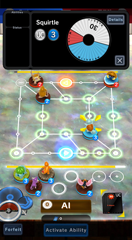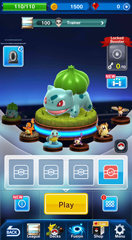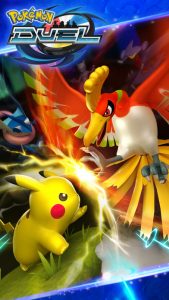Release Date: January 24, 2017
Developer: Heroz
Publisher: The Pokémon Company
Review Spoilers: Minimal
IGN | Metacritic
Being one of the few people who still occasionally play Pokémon Go, I had to give Pokémon Duel a try. Pokémon Duel is free to play person v person (pvp) game that involves strategy, pokémon collecting, and chance.
While I love the actual dueling aspect and some parts of the boosters – ultimately it feels like it will be a waiting game, rather than one I will always be able to pick up and play when I want. A lot of mobile games have gone the way of Facebook gaming, utilizing wait times. Farming games made you wait to harvest crops, but you were still able to do other things in the game. That’s where I feel like Pokémon Duel hits a snag.
First, off the bat there’s already a good wait time before actually starting the game. Not only do you have to install the game from the Play Store or iOS app store, but then install the game via the game app. (Longer than Pokémon Go – it felt like at least.)
The game then needs to connect to their network after you agree to their terms of usage. There is a short intro video of what the tournament is: the Pokémon Figure Games World Tournament. Yes, pokémon themselves aren’t battling but instead figures of them.
Trainers vie for the prize of winning the Jewel Tower (why you would want a whole building as a prize – I have no clue). You have the option to skip both the short background and the seemingly tedious tutorial – but, if like most, this will be their first time playing, how else are you going to learn?
“Well dressed boy,” or as you later learn, Luca, helps teach you to duel which has a few mechanics to it. Mostly it’s a turn based strategy game but instead of battling against AI, it’s an actual human being. Which, now and then you can use to your advantage. The game board is the same no matter who you play and your goal is to maneuver one of your pokémon figures to the other player’s side at the “goal” spot (the blue and orange spot below).

You can choose to initiate battles or skillfully avoid them to reach the goal. Whoever reaches their prospective goal first, wins. Easy right? Some might hope that this is more of a strategy based game or collecting high level pokémon will aide you in winning.
However, it’s more of a game of chance for the most part. The Data Disk (top part of image above) shows the attacks for pokémon. When you attack another pokémon, to either get past them or take their spot on the board, each player’s Data Disk will spin and you touch your screen to hopefully stop it in the right area.
You can predict how this might get frustrating if you have a high attack pokémon facing a low attack one and keep landing on miss or a lower damage attack. You can also use Plates, which are what I like to think of as extra ability cards.
You may play Plates only at the beginning of your turn on one pokémon on the board or benched. Plates may be things like adding 30+ damage to the attack you land on when you attack another pokémon. Or they can be things like healing poisoned pokémon. These may play into your strategy but it’s all really dependent on the spin of the Data Disk.
On top of regular attacks on the Data Disk there are other more passive attacks. These are labeled purple, gold, and blue. On these attacks are stars, the more stars on the attack wins depending on the color of the special attack. During the loading screens they give you more examples but you can also test out scenarios in a training center.
In my experience just starting out playing the game for a few hours, even though I was lower level with basic pokémon and got unfairly matched with higher ranking players, it all came down to the attack spin.
The only way to increase the chances of landing on the desired attack is by leveling up your pokémon. pokémon leveling brings in the other slightly complicated and annoying mechanics of the game. You are able to level up pokémon by using Fusion as well as collecting items and other pokémon. Fusion is basically like gaining an item to give your pokémon more experience points or exp/xp.
Depending on the item you have it may actually not be used for Fusion, which is frustrating, as they don’t have much of a guide on this – that I could find. For example, gold ingots have 1exp listed. You may use it towards the exp. However, until I tried it out, it doesn’t indicate that you can go into the store and trade the ingot for coins. Another example is I have this green fusion item, that I can’t use in fusion or exchange for coins, so you know, I’ll just have to wait until more people play so they can fill me in.
With Fusion, you can also “fuse” pokémon to other pokémon. For example a Meowth with a Bayleaf. I’m not quite sure the rhyme or reason to which pokémon can be used with which. Again, there’s a brief explanation when you are first introduced to the concept, but when I go to look for further stuff in the guides, it’s not there.
When you place two or more items to fuse with pokémon you are also required coins to fuse Pokémon. This currency can be bought through in-app purchases or exchanged with items such as my gold ingot. You can get fusion items and new pokémon by winning battles that get you keys and sometimes booster packs if you level up.
Booster packs are boxes that come in different colors to indicate what you might receive in them – rare pokémon, fusion items, coins, etc. Most, if not all booster packs are on a time lock, meaning you have to wait hours (and I do mean hours, 6+ hours after your first free booster) until you unlock it, the second huge waiting time.
Or you can use the other currency in the game, which are these red gems. The gem currency is what shortens wait times for booster packs, buys new plate cards, and unlocks extra booster pack slots. This is the currency you’ll want to use sparingly as you only start off with 3-5 plates.
But, since you can only unlock one booster pack at a time, you may be tempted to use these gems. This I find is another deterrent to more gameplay, because you can only hold 3 booster packs at a time – the fourth slot can be bought with gems (only for 30 days), as seen below.

Going back to keys, you earn 3 keys per battle you win and 1 key per battle you lose. Every 10 keys you earn, you can get a booster pack. Here’s where the third wait time comes in. After you max out on 10 keys you have to wait approximately 20 hours before being able to gain more keys. This heavily undermines the player’s desire to play more battles than needed per day. This is the one aspect that you cannot use any currency, in-game or real life, to lessen the time of.
The fourth major wait time, is finding a battle itself. Players can do league battles – by simply clicking the play button on the home menu. Or players can do room battles, found under info – the square grid icon on the right.
This sometimes is a faster way to find battles, because you don’t have to wait to be matched by the server. But, Lord help you if there are no available rooms, aka the fifth waiting time. The room battles, can also be used to play friends that might be playing Pokémon Duel, since each person can create a room that can be open or private with a room key. It is my impression that with room battles, you don’t get key rewards and it doesn’t heavily contribute to your league leveling. So, there’s that trade off.
If you’re flustered and are 1. too impatient to wait for a league game or 2. there are no rooms for room battles, you can always go to the training center. There you can unlock certain rewards by completing challenges as you test out strategies of the game. While there are only 10 stages to the training center, you can always go back to them if you’re just itching to battle, for the heck of it.
Overall, while some reviewers may find this to be a flop, based on concept, I enjoy the moving parts of the game. Dueling is fun, when you are able to find a game and not wait a good while. The Fusion aspect is interesting – and I’m a sucker for alchemy mechanics in games – if you don’t have to wait forever for booster pack unlocks. Basically, get used to that loading music.
Whether these may just be starting out wait times that indicate how many people are on the servers or merely the slowness of the game itself is yet to be seen, as it was just released on January 24, 2017. With any game, you want more app usage and in-app time, but with the wait times I find it hard to see people playing the game for more than an hour or two per day (as I did today and now I wait…).
I’m curious to see if other players feel this way and if more players do, if the developers may rearrange some aspects so that players who want to play the game more often are able to and feel like it will benefit them.
Pokémon Duel is currently out in 64 countries and regions worldwide in English and Japanese on iPhone and iPad in the App Store and for Android devices on Google Play!
Update 1/25: Just tried to play again in the training center. Game kept saying “Unknown Error. Returning to title screen.” Oh Pokémon, you know how to toy with our emotions.
Update 1/27: Pokémon Duel also has quests which you can find hidden away by room matches. Why they don’t make an “!” signal to bring your attention to it from the home screen I’m not sure.
If you’re wondering what the green battery bar in the top left of the home screen is, it’s the power you can use to do the quests – basically the campaign. Be warned there is a lot of dialogue in the quests, not a lot of of it is really pertinent to the overall story, other than shady characters and your mouthy AI, Carlo.
In quests you can earn gems from completing challenges just like in the training center. Again, this still uses a wait time, if you run out of power and want to power through the quests, you’ll have to wait for it.
On the other hand there are more rewards for beating quests. Some quests have two reward outcomes (you have to spin to see which one you get), coins or a Pokémon. When you get farther in the quests, you can get one of three rewards: coins, Pokémon, and sometimes another Pokémon or useful plates. Since you can only get one of the rewards per try, you’ll have to keep replaying particular quests if you want to find out what the other rewards are (or go to reddit for a sneak peek).
I figured out what the green cubes or “chain” cubes are for – and that’s adding chain levels to your Pokémon. After filling a chain meter for a particular Pokémon, that Pokémon can receive a higher attack.
Another way of adding chains to the Pokémon is basically to grind and get the same of that Pokémon to fuse with it. And you’ll definitely want to fuse Pokémon and weed out your weaker ones, as you can only hold 50 figures. The 50 includes ingots (gold cubes), chain cubes (green cubes), and experience cubes (blue cubes).
So let’s say you have 48 figures and you’re wanting to timer unlock the sparkly rainbow booster that takes 24 hours. Since it unlocks 5 figures, you have to pare down your figure cabinet before allowing it to countdown.
Lastly, while the load/error times have been better for the most part, they’re still pretty chaotic around peak times (aka 5pm when people get off work). It’s weird that the game focuses more on pvp game play and very much so hides the quests.
Yes, the rewards are better with league battles, but it does weigh down on their servers especially with the surge of people who will play around launch but inevitably dwindle down as time goes on. Personally, unpacking boosters was the fun when I collected Pokémon cards in my youth, but league matches can be unbalanced.
Those who shill out more money can buy more single boosters from the store thereby getting more EX or unique Pokémon with better abilities and attacks. But, we can understand why they’d want to steer people to the in-app purchases. More money, more Pokémon.
If you want to know more tips you can always read up on the ever diligent reddit threads. Or you can message me on twitter for things I’ve learned or to room battle!
